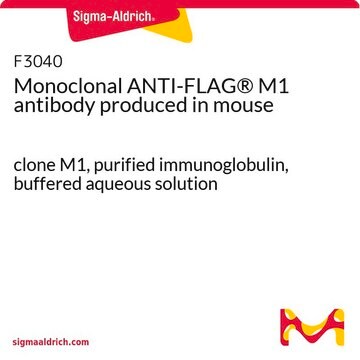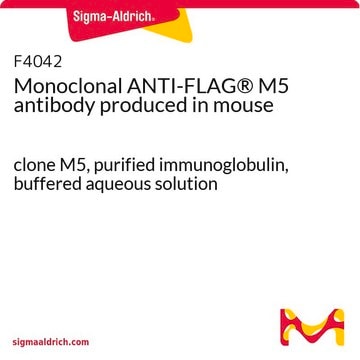A9469
Monoclonal ANTI-FLAG® M2-Alkaline Phosphatase antibody produced in mouse
clone M2, purified immunoglobulin, buffered aqueous glycerol solution
Synonym(s):
Monoclonal ANTI-FLAG® M2 antibody produced in mouse, Anti-ddddk, Anti-dykddddk
About This Item
Recommended Products
biological source
mouse
conjugate
alkaline phosphatase conjugate
antibody form
purified immunoglobulin
antibody product type
primary antibodies
clone
M2, monoclonal
form
buffered aqueous glycerol solution
species reactivity
all
concentration
~1 mg/mL
technique(s)
indirect ELISA: 1:20,000
isotype
IgG1
immunogen sequence
DYKDDDDK
shipped in
wet ice
storage temp.
−20°C
Gene Information
human ... ALPL(249)
Looking for similar products? Visit Product Comparison Guide
General description
Application
Western Blotting (1 paper)
- in direct tissue blot immunoassay of sweet orange petioles samples
- in screening internalization of delta opioid receptor
- for screening cell-free protein expression using ELISA
Physical form
Legal Information
Not finding the right product?
Try our Product Selector Tool.
Storage Class Code
10 - Combustible liquids
WGK
WGK 3
Flash Point(F)
Not applicable
Flash Point(C)
Not applicable
Certificates of Analysis (COA)
Search for Certificates of Analysis (COA) by entering the products Lot/Batch Number. Lot and Batch Numbers can be found on a product’s label following the words ‘Lot’ or ‘Batch’.
Already Own This Product?
Find documentation for the products that you have recently purchased in the Document Library.
Customers Also Viewed
Our team of scientists has experience in all areas of research including Life Science, Material Science, Chemical Synthesis, Chromatography, Analytical and many others.
Contact Technical Service

















